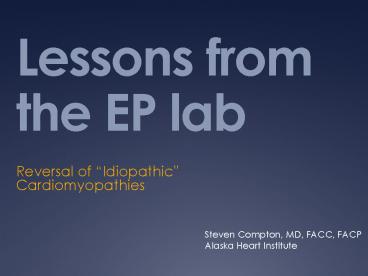Lessons from the EP lab - PowerPoint PPT Presentation
1 / 35
Title:
Lessons from the EP lab
Description:
A disease of unknown etiology that principally affects the myocardium... Li-Fern Hsu, M.B., B.S., Pierre Jais, M.D., Prashanthan Sanders, M.B., B.S., Ph. ... – PowerPoint PPT presentation
Number of Views:59
Avg rating:3.0/5.0
Title: Lessons from the EP lab
1
Lessons from the EP lab
- Reversal of Idiopathic Cardiomyopathies
Steven Compton, MD, FACC, FACP Alaska Heart
Institute
2
Idiopathic Cardiomyopathy
- A disease of unknown etiology that principally
affects the myocardium
Gilbert, EM and Bristow, MR, in Schlant and
Alexander The Heart 8th ed., 1994.
3
Idiopathic Cardiomyopathy
- Diagnosis is established by the presence of LV
dilatation and systolic dysfunction in the
absence of congenital, coronary, valvular,
hypertensive, or pericardial heart disease.
Gilbert, EM and Bristow, MR, in Schlant and
Alexander The Heart 8th ed., 1994.
4
Idiopathic Cardiomyopathy
- Distinct from secondary myocardial diseases that
occur with a specific systemic disorder that may
be metabolic, collagen-vascular, infiltrative,
neuromuscular, inflammatory, toxic, genetic, or
neoplastic in origin.
Gilbert, EM and Bristow, MR, in Schlant and
Alexander The Heart 8th ed., 1994.
5
Idiopathic Cardiomyopathy
- Since IDC is defined clinically, it is likely
that several specific etiologies are responsible
for this condition.
Gilbert, EM and Bristow, MR, in Schlant and
Alexander The Heart 8th ed., 1994.
6
Idiopathic Cardiomyopathyno longer
- Tachycardia induced cardiomyopathy
- Atrial fibrillation-induced cardiomyopathy
- Ventricular ectopy-induced cardiomyopathy
- Dyssynchronous cardiomyopathy
7
Tachycardia-induced cardiomyopathy
- Caused by any sustained, fast rhythm
- Atrial rhythms
- Afib, Aflut, AT
- AVRT, esp. PJRT
- AVNRT
- VT
- Idiopathic VTs
- Ischemic VTs
- BBRT VTs
- Sustained rapid pacing
8
Tachycardia-induced cardiomyopathy
- Clinical clues dating back to 1910
- Reversal with ablation demonstrated late
80s/early 90s - Review article 1997 (Shinbane et al, JACC)
- Heart rate and rhythm control should be
rigorously and rapidly pursued if definite signs
of a cardiomyopathic process have developed.
9
TICM Findings
- Ventricular cardiomyopathy
- Gross changes
- Dilated ventricle
- Reduced LV contractility
- Elevated LV end-diastolic pressure
- Mitral regurgitation (2? to annular dilatation)
- Abnormal LV torsion
- LV diastolic dysfunction
10
TICM Microscopic changes
- Myocyte lengthening, hyperplasia
- Disruption of basement membranesarcolemmal
junction - Reduced myocardial capillaries and reduced blood
flow - Impaired coronary reserve
- Myocardial fibrosis
11
Molecular changes
- ß-receptor expression reduced, transduction
reduced - Reduced adenylate cyclase activity
- Abnormal excitation-contraction coupling
- T-tubule depletion
- Apoptosis
12
Atrial cardiomyopathy
- Atrial dilatation
- Contractile dysfunction
- Abnormal calcium channel function
- Na/Ca2-exchanger upregulation
- Intracellular Ca2 loading
13
Clinical observations
- LV dysfunction correlates with
- Tachycardia rate
- Tachycardia duration
- Ventricular vs. atrial mechanism
- Reports of reversal with ablation relate to
grossly observed LV contractility. Reversal of
LV dysfunction may not be complete.
14
Afib induced CM
- 36 y/o WM with lone afib
- Normal echo and thyroid studies. Holter mean
rate 74 bpm. - 3 years later
- Exertional intolerance. LVEF 30, mild MR.
Fails dofetilide, declines amiodarone.
15
Atrial fibrillation ablation
16
Post ablation
- 4 weeks post ablation
- Bags fall moose, 3 mile haulout
- Back to full activity
- 6 months post ablation
- Persistent NSR
- Normal LV function
- 2 years post ablation
- NSR, Normal LV
17
Catheter Ablation for Atrial Fibrillation in
Congestive Heart Failure
Li-Fern Hsu, M.B., B.S., Pierre Jais, M.D.,
Prashanthan Sanders, M.B., B.S., Ph.D., Stephane
Garrigue, M.D., Ph.D., Meleze Hocini, M.D.,
Frederic Sacher, M.D., Yoshihide Takahashi, M.D.,
Martin Rotter, M.D., Jean-Luc Pasquie, M.D.,
Ph.D., Christophe Scavee, M.D., Pierre Bordachar,
M.D., Jacques Clementy, M.D. and Michel
Haissaguerre, M.D.
N Engl J Med Volume 351232373-2383 December 2,
2004
18
Improvement in Left Ventricular (LV) Function and
Dimensions after Ablation in Patients with
Congestive Heart Failure
19
Hsu, L. et al. N Engl J Med 20043512373-2383
20
AF Cardiomyopathy
- Restoration of sinus rhythm by ablation of AF in
CHF can significantly improve cardiac function,
symptoms, exercise capacity, and quality of life. - Cardiomyopathy can improve or resolve despite
prior rate control. - Mechanisms of improvement?
- Regularization of ventricular activation?
- Restoration of atrial transport function?
21
AF Cardiomyopathy
- AVN ablation/BIV vs PVI trial rate controlled
patients
Khan et al, N Engl J Med 20083591778-85.
22
PVC-induced Cardiomyopathy
LVEF 40 NYHA III
LVEF 55 NYHA I
23
PVC-induced Cardiomyopathy
- Resolves with treatment
- First description 2000 (Chugh et al JCVEP)
- Independent of PVC source
- RVOT
- LV septum
- Ischemic scar
- Mechanism?
24
Dyssynchronous Cardiomyopathy
25
Case Report
- 58 y/o IDC EF 10, Class IV CHF
- Bimonthly hospitalizations for CHF
- Maximally tolerated medical therapy
26
Carl Kron
Marked First Degree AV block LBBB
27
Class IV
28
Epicardial LV Lead
29
Class IV
30
Class II
Class IV
31
LVEF 10 NYHA IV
LVEF 50 NYHA I
2002
32
Super-responders
- Decrease in New York Heart Association functional
class 1 - 2-fold or more LVEF increase or final LVEF gt45,
- and
- Decrease in LV end-systolic volume gt15
Antonio et al, Europace 2009 11(3)343-349
33
Super-responders
- Definitions vary but involve restoration of
near-normal or normal LV function. - 7-22 of CRT patients super-respond
- Predictors absence of scar, shorter duration of
dysfunction, less LV dilatation. - Implies existence of dyssynchrony as sole cause
of cardiomyopathy in some patients.
Antonio et al, Europace 2009 11(3)343-349 Ypenbur
g et al, JACC 2009 53(6)483-490
34
Dyssynchronous Cardiomyopathy
35
Idiopathic Cardiomyopathyno longer
- Tachycardia induced cardiomyopathy
- Atrial fibrillation-induced cardiomyopathy
- Ventricular ectopy-induced cardiomyopathy
- Dyssynchronous cardiomyopathy































